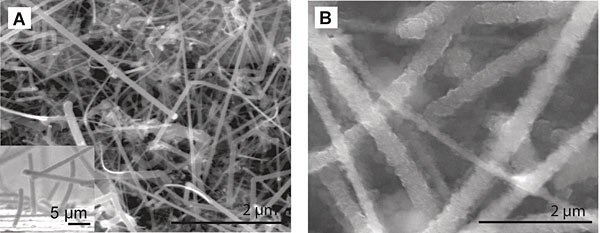Home > Press > Stanford's nanowire battery holds 10 times the charge of existing ones
 |
| Photos taken by a scanning electron microscope of silicon nanowires before (left) and after (right) absorbing lithium. Both photos were taken at the same magnification. |
Abstract:
Stanford researchers have found a way to use silicon nanowires to reinvent the rechargeable lithium-ion batteries that power laptops, iPods, video cameras, cell phones, and countless other devices.
Stanford's nanowire battery holds 10 times the charge of existing ones
PALO ALTO, CA | Posted on December 18th, 2007The new version, developed through research led by Yi Cui, assistant professor of materials science and engineering, produces 10 times the amount of electricity of existing lithium-ion, known as Li-ion, batteries. A laptop that now runs on battery for two hours could operate for 20 hours, a boon to ocean-hopping business travelers.
"It's not a small improvement," Cui said. "It's a revolutionary development."
The breakthrough is described in a paper, "High-performance lithium battery anodes using silicon nanowires," published online Dec. 16 in Nature Nanotechnology, written by Cui, his graduate chemistry student Candace Chan and five others.
The greatly expanded storage capacity could make Li-ion batteries attractive to electric car manufacturers. Cui suggested that they could also be used in homes or offices to store electricity generated by rooftop solar panels.
"Given the mature infrastructure behind silicon, this new technology can be pushed to real life quickly," Cui said.
The electrical storage capacity of a Li-ion battery is limited by how much lithium can be held in the battery's anode, which is typically made of carbon. Silicon has a much higher capacity than carbon, but also has a drawback.
Silicon placed in a battery swells as it absorbs positively charged lithium atoms during charging, then shrinks during use (i.e., when playing your iPod) as the lithium is drawn out of the silicon. This expand/shrink cycle typically causes the silicon (often in the form of particles or a thin film) to pulverize, degrading the performance of the battery.
Cui's battery gets around this problem with nanotechnology. The lithium is stored in a forest of tiny silicon nanowires, each with a diameter one-thousandth the thickness of a sheet of paper. The nanowires inflate four times their normal size as they soak up lithium. But, unlike other silicon shapes, they do not fracture.
Research on silicon in batteries began three decades ago. Chan explained: "The people kind of gave up on it because the capacity wasn't high enough and the cycle life wasn't good enough. And it was just because of the shape they were using. It was just too big, and they couldn't undergo the volume changes."
Then, along came silicon nanowires. "We just kind of put them together," Chan said.
For their experiments, Chan grew the nanowires on a stainless steel substrate, providing an excellent electrical connection. "It was a fantastic moment when Candace told me it was working," Cui said.
Cui said that a patent application has been filed. He is considering formation of a company or an agreement with a battery manufacturer. Manufacturing the nanowire batteries would require "one or two different steps, but the process can certainly be scaled up," he added. "It's a well understood process."
Also contributing to the paper in Nature Nanotechnology were Halin Peng and Robert A. Huggins of Materials Science and Engineering at Stanford, Gao Liu of Lawrence Berkeley National Laboratory, and Kevin McIlwrath and Xiao Feng Zhang of the electron microscope division of Hitachi High Technologies in Pleasanton, Calif.
####
For more information, please click here
Contacts:
Dan Stober
Stanford News Service:
(650) 721-6965
Yi Cui
Department of Materials Science and Engineering
(650) 723-4613
Copyright © Stanford University
If you have a comment, please Contact us.Issuers of news releases, not 7th Wave, Inc. or Nanotechnology Now, are solely responsible for the accuracy of the content.
| Related News Press |
Discoveries
![]() Researchers develop molecular qubits that communicate at telecom frequencies October 3rd, 2025
Researchers develop molecular qubits that communicate at telecom frequencies October 3rd, 2025
![]() Next-generation quantum communication October 3rd, 2025
Next-generation quantum communication October 3rd, 2025
![]() "Nanoreactor" cage uses visible light for catalytic and ultra-selective cross-cycloadditions October 3rd, 2025
"Nanoreactor" cage uses visible light for catalytic and ultra-selective cross-cycloadditions October 3rd, 2025
Announcements
![]() Rice membrane extracts lithium from brines with greater speed, less waste October 3rd, 2025
Rice membrane extracts lithium from brines with greater speed, less waste October 3rd, 2025
![]() Researchers develop molecular qubits that communicate at telecom frequencies October 3rd, 2025
Researchers develop molecular qubits that communicate at telecom frequencies October 3rd, 2025
![]() Next-generation quantum communication October 3rd, 2025
Next-generation quantum communication October 3rd, 2025
![]() "Nanoreactor" cage uses visible light for catalytic and ultra-selective cross-cycloadditions October 3rd, 2025
"Nanoreactor" cage uses visible light for catalytic and ultra-selective cross-cycloadditions October 3rd, 2025
Battery Technology/Capacitors/Generators/Piezoelectrics/Thermoelectrics/Energy storage
![]() Rice membrane extracts lithium from brines with greater speed, less waste October 3rd, 2025
Rice membrane extracts lithium from brines with greater speed, less waste October 3rd, 2025
![]() Sensors innovations for smart lithium-based batteries: advancements, opportunities, and potential challenges August 8th, 2025
Sensors innovations for smart lithium-based batteries: advancements, opportunities, and potential challenges August 8th, 2025
![]() Deciphering local microstrain-induced optimization of asymmetric Fe single atomic sites for efficient oxygen reduction August 8th, 2025
Deciphering local microstrain-induced optimization of asymmetric Fe single atomic sites for efficient oxygen reduction August 8th, 2025
|
|
||
|
|
||
| The latest news from around the world, FREE | ||
|
|
||
|
|
||
| Premium Products | ||
|
|
||
|
Only the news you want to read!
Learn More |
||
|
|
||
|
Full-service, expert consulting
Learn More |
||
|
|
||








